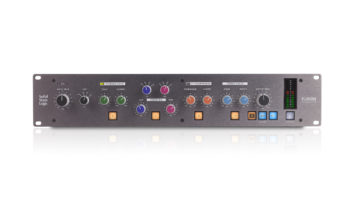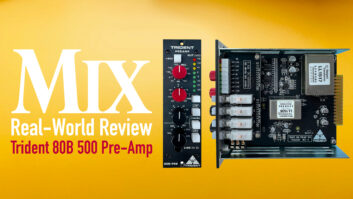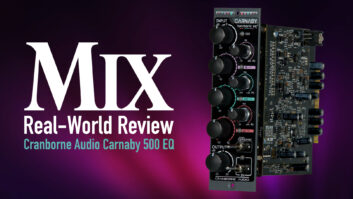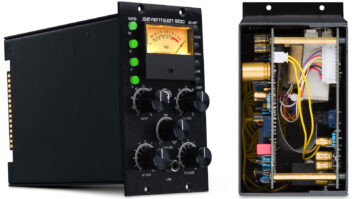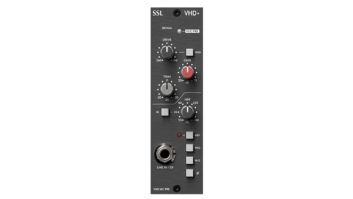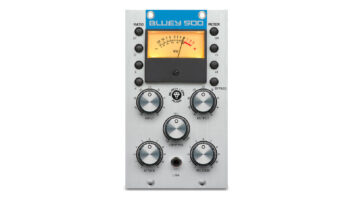The Elysia Skulpter 500 sound shaping mic preamp is a single-slot professional microphone/DI/Line preamp channel that combines precise control, two distinctly different kinds of pleasing analog coloration and a smooth, analog compressor.
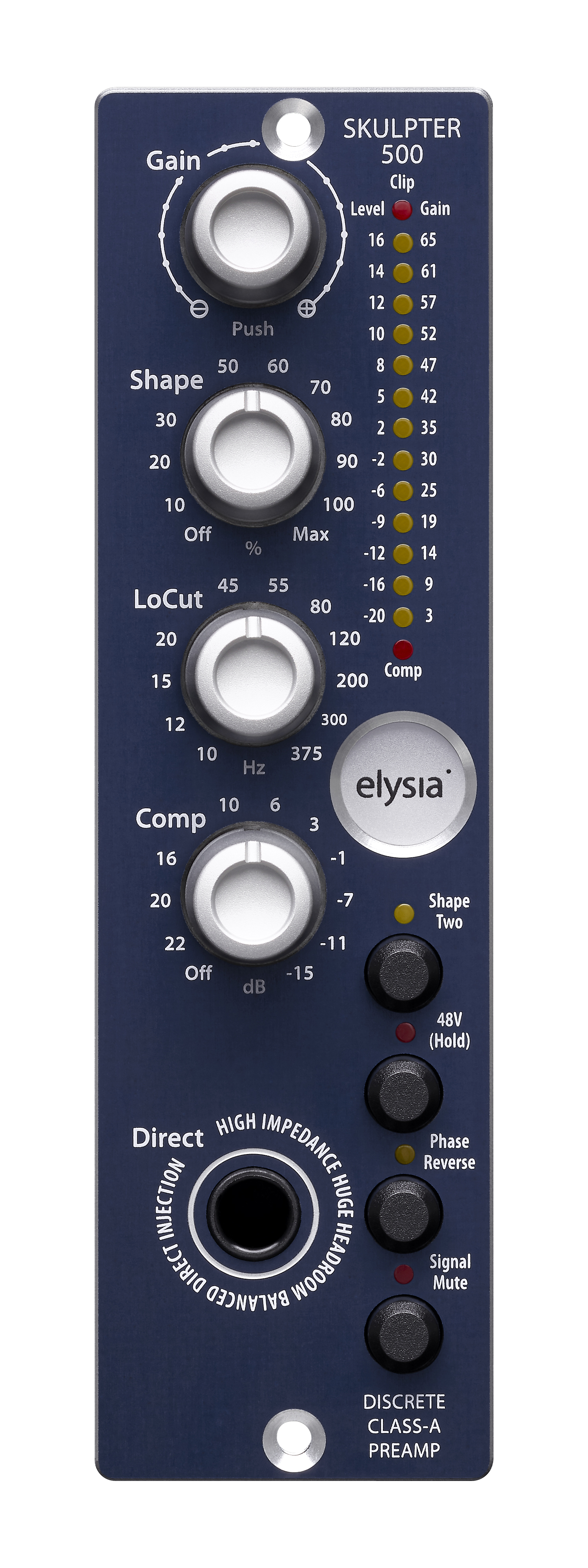
The single-channel Skulpter starts with a Class-A transformerless mic preamp with a repeatable, stepped-gain attenuator control using a continuous rotary encoder—not a conventional potentiometer. The encoder has 20 steps per revolution, with gain adjustable over 40 steps in 1.5 to 2 dB increments. Total gain ranges from only 3 dB at full CCW up to 65 dB at full CW. As I turned the Gain control, “under the hood” I could hear various relays toggling in/out cascades of precision resistors.
On the front panel is a balanced DI instrument TRS jack that uses a JFET buffer circuit with a 1-megaohm input impedance. I had no problem plugging in a regular (unbalanced) guitar cord and recording bass, synths or a direct guitar. Both the DI path and the microphone input will accept up to a +19 dBu signal level, so there is no need for an attenuator pad switch.
When used, this DI path automatically takes priority over the mic input path. If phantom power is switched on the mic input, when plugging into the DI the output will mute automatically. I could keep a mic plugged in all the time and just plug in a DI bass into the front panel when needed. Pretty handy!
Both the microphone and direct input level are set with the same Gain control, and each can have and store different settings. When switching between them, the gain changes automatically to the previously selected value for each. When Skulpter is powered off, both gain values are held in a microprocessor chip that also stores the input switching state and LED clip metering, as well as the last setup of the rest of the controls and switches.
Specifications are given as minimum gain at 3 dB and medium gain at 29 dB. Frequency response is 10 Hz to 17 kHz (–3 dB), and THD+N @ +6 dBu input level is 0.007 percent. The noise floor (A-weighted) specs at the same two gain settings are –97 dBu and –93 dBu, respectively.
Complete Signal Chain
The Skulpter 500 signal chain is arranged in this order: Instrument Buffer (DI) or the Mic Pre-Amp section, a variable 10 Hz to 375 Hz 12 dB/octave Low Cut filter, the Shape section, and a fixed, 3:1 ratio soft-knee compressor. Front-panel buttons include: Output Mute, +48-volt phantom on/off, Phase (polarity) reversal and Shape 2 select.
Skulpter’s Shape process is a combination of saturation and a specially designed bandpass filter that are both controlled simultaneously by the single Shape control located directly under the Gain control on the front panel.
Shape 1 (default) is designed for musical instruments and is characterized by a broadband EQ curve with a high-frequency 6 dB/octave rolloff starting at 4 kHz. As it should be, the amount of Shape’s saturation is dependent on the applied input signal level, the Gain control setting and the setting of the Shape control. I liked the fact that when Shape is set at fully CCW, it is out of circuit.
Pushing the Shape 2 button changes the filter to a shelving boost of up to 10 dB at 4.5 kHz (6 dB/octave) and a high frequency rolloff starting at 10 kHz (another 6 dB/octave filter). Shape 2 is said to be for vocals, but I found it also useful for instruments—especially for overly “dark,” somber-sounding drums and guitars.
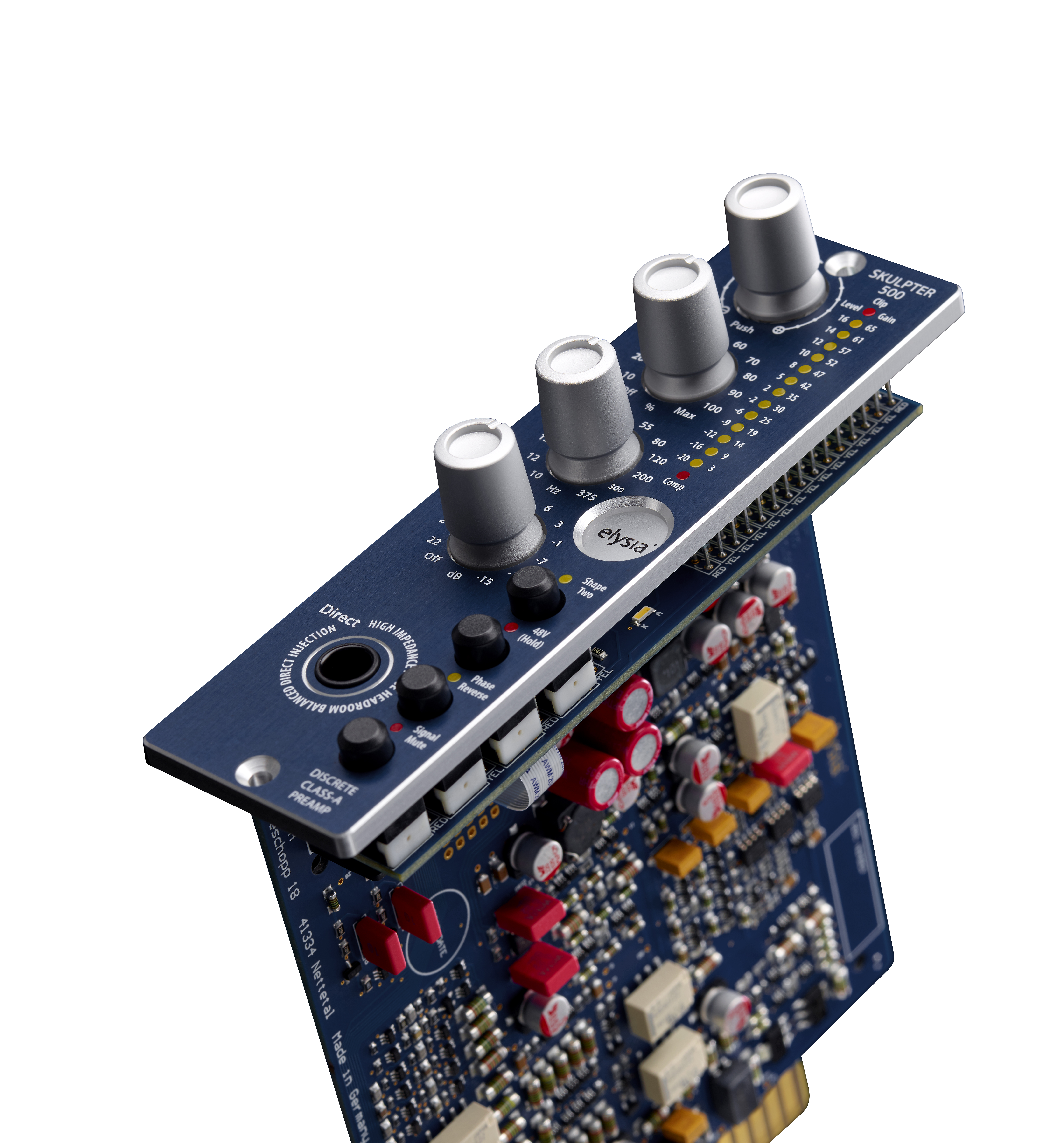
Included with Skulpter is an excellent compact, spiral-bound printed handbook with response curves for the two Shapes, as well as the compressor’s transfer function graph. Bring back printed manuals like this!
The single-knob compressor changes gain by placing a VCA made from a “discrete transistor array” (not a VCA chip) in the negative feedback path of the output amplifier. Here, the audio signal is “looked at” but does not actually pass directly through it. The compressor uses a version of Elysia’s Auto Fast attack time feature found on their xpressor 500 module. Release time is an exponential shape that works well—it always seemed as fast as possible, without adding distortion.
The front panel has a dual-scale multi-function LED meter. I immediately noticed that when adjusting the Gain encoder, pushing in on it toggles the meter between reading the numerical preamp gain value on a scale on the right side of the meter and the actual output level of the module on a scale on the left side.
But the meter also has a red LED at the bottom that varies in brightness to indicate compression amount. There is another red LED at the top of the meter that also varies in brightness to show input overload intensity. In regular practice, I found it was better never to light either of these two red LEDs. It would be a good idea to be able to push in on the Compressor knob and momentarily toggle the meter to show gain reduction.
Related: Review: Rupert Neve Designs 5211, by Mike Levine, Jan. 17, 2019
In the Studio
When I first powered up my 500 rack, Skulpter came up in Output mute for about three seconds. All previous front-panel settings are recalled automatically, including the state of phantom power—on/off. To turn on phantom powering, you have to hold down the 48V button until it changes from flashing to solid red; to turn phantom off, hold it down again. Phantom power is only available at the rear edge connector (for microphones) and not at the front-panel TRS DI input.
First use was on drum overhead tracks with a pair of Skulpters patched as a line-level hardware insert in a Pro Tools mix. I got into the habit of starting with the Gain control at minimum (+3 dB) with all controls CCW, or off. The compressor attacks quickly, and, up to about midway in its range, it doesn’t soften the transients too much. I used the red compressor overload LED as a warning.
Past about midway and with constant LED warnings, you’ll “put the kibosh on” and start to lose overall level. Here I could use a separate makeup gain for using this squashed effect, but it also works to just crank the track back up in the mix.
I liked the Lo Cut filter’s gentle action—it’s before the compressor and cleans up the low frequencies exactly as you’ll want. However, I do wish it could be routed to the compressor side-chain. I tried paralleling the outputs of the two Skulpters with the original overhead tracks, and it worked great to bring up low level sound—ride cymbals, room tone and snare and kick ambience.
For a full kit drum loop, Shape 2 will brighten it without problem, but I ended up with Shape 1 so that the cymbals didn’t get too loud. With a lot of compression, it is easy to hear the room ambience recorded in the overheads.
With Shape fully off at CCW, Skulpter is an extremely clean mic preamp and compressor channel! Extreme gain reductions are possible with minimum artifacts and noise. I found that, as I increased the Compressor knob, there was an obvious point where it was just right—and then I would back it down a couple of clicks.
Want more stories like this? Subscribe to our newsletter and get it delivered right to your inbox.
Guitars and Vocals
Using Skulpter to record electric guitar worked completely differently than I expected; it’s more like setting the overdrive channel on a guitar amp.
For recording my 5-watt MOD Kits DIY MOD 102+ amp kit, my starting setup for recording an electric guitar was all Skulpter controls full CCW and the gain set to 35 dB. I used a Royer R-10 ribbon mic positioned off-center of a Hellatone (Celestion) 12-inch speaker in an Avatar open-back cabinet.
With my Fender Strat and a clean amp sound, I was able to hear the different tones possible with the Skulpter. Using Shape 1 thickens up the sound nicely and much differently than using an equalizer. Shape 2 brightens the sound greatly—I liked it, too. Turning up the compressor “compacts” the sound well, as expected, but I did have to make up recording level. Again, I miss an output level control here.
I tried recording the same guitar direct and just loved adding some Shape 2 to its sound. This is the best direct path for a bright, super-clean-sounding guitar with just a little colored saturation and compression. I would always use Skulpter for this instead of any DI box or guitar pedal! There is much more control over the finished sound, and it’s clean—even with lots of compression.
I also tried recording a Taylor 110 acoustic guitar. I used a Lewitt LCT 540 S cardioid condenser with 80 Hz rolloff placed over the 12 fret at about 8 inches away. Even though the guitar could use some new strings, I got an incredibly clean and focused tone with no preamp noise. I did notice “zipper” noise when dialing in gain while the guitarist played. It is the relays switching in gain resistors, and I don’t advise doing this while recording. But this is also true for any rotary-switched gain controls, such as on a vintage Neve 1073 module.
When connected to my Soundelux Bock U195 cardioid FET condenser microphone, Skulpter produced a warm, rich vocal sound. I used no pad or low-cut filter on the mic itself, but I did flip in the FAT switch. This microphone has tremendous headroom and can distort a mic preamp without an attenuator pad switched in.
Having a minimum gain position on the Skulpter 500 of just 3 dB is a perfect starting position for this mic and other modern microphones that supply ample output level. As on the acoustic guitar recording session, my super-loud singer’s vocal tracks recorded super-quiet and clean, and the result sounded great.
Super Skulpter
Elysia has a winner with this unique sound-shaping microphone/DI channel. I found it a worthy contender to lead in a new class of modern audio processors. I’ve made room in my 500 rack for these two review units, as they are proving to be indispensible! Highly recommended!
Product Summary
Company: elysia GmbH
Product: Elysia Skulpter 500
Website: www.elysia.com
Price: $850 MSRP
Pros: Pristine—or colorful—channel strip
Cons: Needs a Makeup Gain control
